Chapter 6 Tissues Class 9 Science Important Questions with Answers PDF will help you in scoring more marks in your exams.
Tissues Class 9 Important Questions and Answers Science Chapter 6
Very Short Answer Questions
Question 1.
Name the tissue present in soft parts of the plants like pith and cortex. (CCE 2010)
Answer:
Parenchyma
More Resources
- Previous Year Question Papers for CBSE Class 9 Science
- NCERT Solutions for Class 9 Science
- NCERT Exemplar Solutions for Class 9 Science
- Value Based Questions in Science for Class 9
- HOTS Questions for Class 9 Science
Question 2.
Where is apical meristem found ? (CCE 2010)
Answer:
At the tips of main stem, main root and their branches.
Question 3.
State one function of parenchyma. (CCE 2010)
Answer:
Storage of food.
Question 4.
Which is the function of xylem ?
(CCE 2010)
Answer:
Transport of sap (water + minerals).
Question 5.
What is the function of phloem ? (CCE 2010)
Answer:
Translocation of food.
Question 6.
Identify the part marked ‘B’ in the diagram. (CCE 2013)
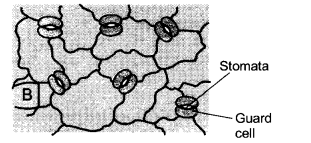
Answer:
Epidermal cell.
Question 7.
State the function of epidermal cells of roots. (CCE 2013)
Answer:
Absorption of water and minerals from soil.
Question 8.
Name the protein present in the muscles which is respon¬sible for movement. (CCE 2013)
Answer:
Myosin (moves over actin during contraction of muscle fi¬bre).
Question 9.
Name the tissue present under the skin and arranged in a pattern of layers. (CCE 2013)
Answer:
Muscular tissue.
Question 10.
Which meristem is responsible for transformation of stem of a plant into trunk when it grows into a tree ? (CCE 2013)
Answer:
Lateral meristem.
Question 11.
Name two elements of water conducting tissue which are re-sponsible for conduction. (CCE 2013)
Answer:
Tracheids and vessels, collectively called tracheary elements.
Question 12.
Name the chemical substance which gets deposited in the walls of sclerenchyma. (CCE 2013)
Answer:
Lignin.
Question 13.
Identify the part marked ‘X’ in the diagram. (CCE 2014)
Answer:
Lumen.
Question 14.
Write any one characteristic of meristematic tissue. (CCE2014)
Answer:
Immature, thin-walled compactly ar¬ranged cells capable of division.
Question 15.
State the role oflarge air cavities present in parenchyma of aquatic plants.
(CCE 2014)
Answer:
Storage of metabolic gases (CO2, O2) and providing buoyancy.
Question 16.
Name the complex permanent tissue in plants in which the materials can move in both directions. (CCE2014)
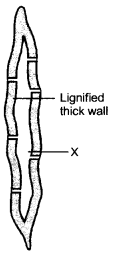 Answer:
Answer:
Phloem.
Question 17.
Name the type of tissue found in respiratory tract. (CCE 2014)
Answer:
Ciliated columnar epithelium.
Question 18.
State two functions ofthe adipose tissue. (CCE 2015)
Answer:
- Storage of fat
- Insulation
- Cushions around organs
- Body contours (rounding off).
Question 19.
Name the tissue which is responsible for increase in girth of stem and root. ( CCE 2015)
Answer:
Lateral meristem (vascular cambium and cork cambium).
Question 20.
Name the tissue that covers most of the organs and forms a barrier to keep different body systems separate. Write its one important function. (CCE 2016)
Answer:
Epithelium. Function. Protection by surface epithelium of skin from drying up, microbes, chemicals and injury.
Question 21.
Water hyacinth floats on water surface. Why ? (CCE 2016)
Answer:
Presence of aerenchyma and large air cavities in petioles.
Short Answer Questions (2 marks)
Question 1.
Identify the type of plant tissue given Label parts A and B. Where in the stem of a plant would you find this tissue ?
(CCE 2010, 2011, 2013)

Answer:
(a) Phloem. Outer side of vascular strand.
(b) A – Sieve tube cell.
B – Companion cell.
Question 2.
Differentiate between aerenchyma and chlorenchyma.
Answer:


Question 3.
(a) Identify the region of the stem marked A in the diagram and the type of simple permanent tissue found in this region
(b) Mention any two characteristic features of the cells found in this tissue. (CCE 2010)
Answer:
(a) A-Epidermis. The permanent tissue forming the epidermis is parenchyma.
(b) Characteristic
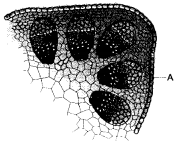
Features:
- Cells are elongated and com-pactly arranged without any intercellular spaces.
- Presence of a layer of non- cellular cuticle on the outer surface for protection and reduction of water loss.
Question 4.
List two characteristics of cork cells which help them to function as protective tissue. (CCE 2010, 2012)
Answer:
- Suberin: Cork cells are impermeable to water vapours due to deposition of suberin over their cells.
- Dead Cells: Cork cells are dead, filled with tannins, resins and air.
Question 5.
Why does growth of a plant occur in specific regions ? Where are the following found
(a) Intercalary meristem
(b) Lateral meristem? (CCE 2010)
Answer:
Meristem. Plants possess a special tissue or meristem for growth. It occurs at specific regions like apices, nodal areas and sides. Accordingly growth occurs only in those areas where meristematic tissue or meristem is present, viz., api¬ces, nodal regions and girth.
(a) Intercalary Meristem. It occurs above or below the nodes and the base of leaves.
{b) Lateral Meristem. It occurs on the sides, both in stem and root.
Question 6.
Name the connective tissue which helps is the repair of tissues. State where this tissue is found. Mention one more » fonction. (CCE 2010,2011,2012)
Answer:
Areolar tissue (a connective tissue).
Location: It occurs inside organs, around blood vessels, muscles and nerves, below skin (subcutaneous tissue) and joining various structures like muscles with skin.
Other Function: Filling, packing and covering organs.
Question 7.
List any four salient features of meristematic tissue.
(CCE 2010, 2011, 2012)
Answer:
- Cells: Cells are small, spherical or polygonal with thin elastic wall.
- Intercellular Spaces: They are absent.
- Cell Contents: Nucleus is large. Cytoplasm is dense while vacuoles are absent.
- Activity: The cells have high anabolic rate. They grow and divide repeatedly.
Question 8.
Which elements of xylem
- Help in transport of water and minerals,
- Store food and
- Provide mechanical support. (CCE 2010, 2011)
Answer:
- Transport: Vessels and tracheids.
- Food Storage: Xylem parenchyma
- Mechanical Support: Xylem fibres, tracheids and ves-sels.
Question 9.
Draw diagram of a neuron showing nucleus and cell body/dendrite, axon, nerve endings.
(CCE 2010, 2011, 2012)
Answer:
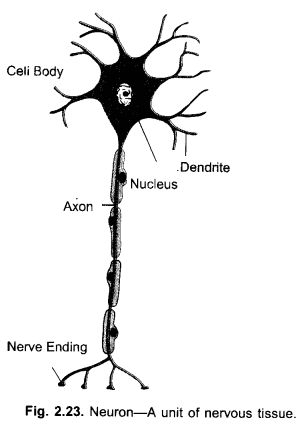
Question 10.
(a) In which connective tissue, matrix contains salts of calcium and phosphorus ?
(b) Which connective tissue is present in ear ?
(c) Which connective tissue connects two bones ?
(d) Which connective tissue is found in bone marrow ?
(CCE 2010, 2011)
Answer:
(a) Bone
(b) Cartilage
(c) Ligament (dense, yellow fibrous connective tissue)
(d) Areolar tissue.
Question 11.
Name four types of elements of phloem.
(CCE 2010, 2011)
Answer:
- Sieve tube cells
- Companion cells
- Phloem Paren-chyma
- Phloem fibres.
Question 12.
Name the tissue that smoothens bone surfaces at the joints. Describe its structure with the help of a diagram.
(CCE 2010, 2011)
Answer:
Cartilage. It has a covering of fibrous connective tissue called perichondrium. Blood supply is restricted to it. Internally there is a layer of cartilage forming cells or chondroblasts. Then there is a solid but flexible matrix of protein-sugar complex chondrin. Matrix contains lacunae having 1 -4 living cartilage cells called chondrocytes.
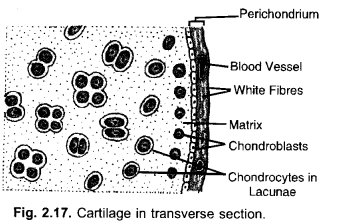
Question 13.
Name the simple permanent tissue which
(a) forms the basic packing tissue
(b) Provides flexibility in plants.
(CCE 2010, 2011)
Answer:
(a) Basic Packing Tissue: Parenchyma,
(b) Flexibility: Col- lenchyma.
Question 14.
In a temporary mount of leaf epidermis, we observe small pores.
(a) What are the pores present in leaf epidermis called ?
(b) How are these pores beneficial to the plant ?
(CCE 2011, 2012, 2015)
Answer:
{a) The pores found in the leaf epidermis are stomata.
{b) The epidermal pores or stomata are the sites of gaseous exchange and transpiration.
Question 15.
What are the two components of blood ? Why is blood considered a type of connective tissue ?
(CCE 2011, 2012)
Answer:
(a) Components. Plasma and blood cells.
(b)
(i) Blood is considered connective tissue as it contains cells suspended in a fluid matrix,
(ii) Further, it connects all parts of the body receiving and providing materials every where.
Question 16.
What is the chemical substance that makes the cells of sclerenchyma hard ? Mention where the tissue is likely to be present. (CCE 2011)
Answer:
(a) Lignin
(b) Around vascular bundles, hypodermis of monocot stem, bundle caps, hard covering of seeds and nuts, husk of coconut.
Question 17.
List any two differences between the structure and location of striated and unstriated muscles. (CCE 2011)
Answer:
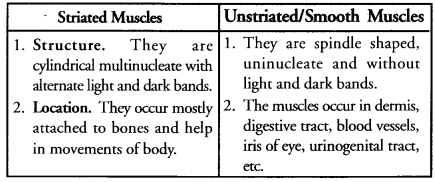
Question 18.
List any two differences between striated and cardiac muscles with respect to their structure and location. (CCE 2011)
Answer:
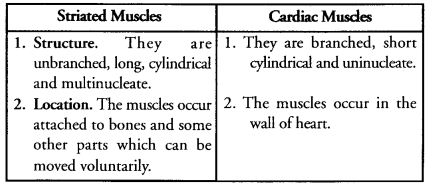
Question 19.
State one function each of
(a) Areolar tissue
(b) Cuboidal epithelium. (CCE 2011, 2013)
Answer:
(a) Areolar Tissue: Binding, packing and covering of body organs besides providing materials for repair of injury.
(b) Cuboidal Epithelium: Stratified epithelium provides protection while simple one takes part in absorption, excretion, secretion and forming germinal layer.
Question 20.
(a) Mention the location of apical meristem in plants.
(b) Name the tissue responsible for movement of the body. (CCE 2011)
Answer:
(a) Tips of stems, roots and their branches
(b) Muscle tissue.
Question 21.
Write the function of bone, cartilage, ligament and tendon.
(CCE 2011, 2012)
Answer:
Bone: It forms supporting framework of body and protects vital organs like brain, heart and lungs.
Cartilage: It provides support, frictionless movement and flexibility to various body parts.
Ligament: It connects a bone to another bone and provides for movement at the joints.
Tendon: It attaches muscle to bone for movement of body parts.
Question 22.
(a) State two important functions of areolar tissue.
(b) Why are skeletal muscles known as striated muscles ?
(CCE 2011, 2013)
Answer:
(a) (i) Binding, packing and covering of body parts.
(ii) Providing materials for repair of injury.
(iii) Connecting skin with underlying muscles.
(b) Due to presence of alternate light and dark bands.
Question 23.
(a)
(i) Name the process by which meristematic tissue changes into permanent tissues.
(ii) Name the simple permanent tissue which contains chlorophyll in it.
(b) Aquatic plants float in water. Give reason for this act.
(CCE 2011)
Answer:
(a)
(i) Differentiation.
(ii) Chlorenchyma.
(b) Aerenchyma, that stores gases, provides buoyancy to aquatic plants and help them float over water.
Question 24.
(a) In the diagram of meristematic tissue in the plant body given here, identify the type of meristematic tissue found in the regions marked ‘A’ and ‘B’ of a stem,
(b) State one function of each. (CCE2011, 2012)

Answer:
(a) A – apical meristem.
B — lateral meristem.
(b) Function:
A – increase in length (stem, root).
B – increase in girth (stem, root).
Question 25:
(a) Give the other name of dividing cells in plants.
(b) In which part of plants, apical meristem is present ? Also mention its function. (CCE 2011)
Answer:
(a) Meristematic cells (meristematic tissue).
(b) Apices or growing points of stems, roots and their branches. Apical meristem takes part in growth in length.
Question 26.
A horse and a mango tree are both complex living organisms with specialised yet different tissue systems to perform the basic life processes. Give the reasons for possessing different tissues to perform similar functions. (CCE2012)
Answer:
- Support: In Mango which is fixed, the supportive tissue is dead and requires little maintenance. In horse, the supportive tissue is organised to provide mobility.
- Growth: Mango has to discard older organs as it does not have an excretory system. It, therefore, continues to grow throughout life with the help of meristems. Horse has an excretory system. It does not discard old structures. Therefore, it stops growing after attaining maturity.
Question 27.
Write two basic structural differences between parenchyma and collenchyma. (CCE 2012)
Answer:
- Shape: Parenchyma cells are isodiametric while collenchyma cells are elongated,
- Wall: It is thin in parenchyma and unevenly thickened (generally at corners) in collenchyma.
- Intercellular Spaces: They occur in parenchyma but are negligible in collenchyma.
Question 28.
(a) Voluntary muscles are also known as skeletal muscles. Justify.
(b) Give two structural characteristics of these voluntary muscles. (CCE 2012)
Answer:
(a) Voluntary muscles are also known as skeletal muscles as they are usually attached to bones and take part in their movements as per our will.
(b) Structural Characteristics.
(i) Presence of alternate dark bands,
(ii) Multinucleate nature.
Question 29.
Given is the diagram showing longitudinal section of parenchymatous tissue. Label the parts M, N, O and P in the given diagram. (CCE 2012)
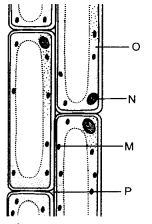
Answer:
M- chloroplast.
N – nucleus.
O – cytoplasm.
P – intercellular space.
Question 30.
The epidermis in desert plants is covered by a waxy coating. Name the substance which constitutes the coating. State three advantages of this coating. (CCE 2012)
Answer:
Coating or cuticle is made of cutin and wax.
Advantages:
- Strength: Coating provides strength to epidermis,
- Protection: It protects the living surface cells against abrasive action of wind,
- Transpiration: The thick coating reduces transpiration.
Question 31.
List any two functions of epithelial tissue in human body.
(CCE 2012)
Answer:
(i) Protection: Being surface layer, epithelium protects the underlying structures from injury, microbes, toxins and desiccation.
(ii) Exchange: It takes part in exchange of gases in lungs (between alveoli and blood capillaries) and exchange of gases and materials in tissues (between blood capillaries and tissue fluid).
Question 32.
List four functions of blood.
Answer:
- Transport: Blood transports gases, nutrients, hormones and waste materials to various parts of the body.
- Heat: It distributes heat throughout the body.
- Tissue Fluid: It forms tissue fluid from its plasma.
- Immunocytes: Blood possesses immunocytes for fighting foreign microbes.
Question 33.
State two differences between chlorenchyma and parenchyma. (CCE 2012)
Answer:
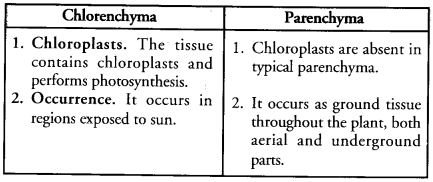
Question 34.
Write two locations of
(i) Simple squamous epithelium
(ii) Cuboidal epithelium. (CCE 2012)
Answer:
(i) Simple Squamous Epithelium: Alveoli, blood capillaries.
(ii) Cuboidal Epithelium: Germinal epithelium, Kidney tubules.
Question 35.
Name the tisue that makes husk of coconut. Write three characteristics of this tissue. (CCE 2012)
Answer:
Sclerenchyma.
Three Characteristics:
- Long narrow spindle-shaped cells,
- Thick lignified wall with pits,
- Dead cells with narrow lumen.
Question 36.
(a) Name the connective tissue which connects two bones.
(b) Name the connective tissue present in external ear.
(CCE 2012)
Answer:
(a) Ligament,
(b) Cartilage.
Question 37.
List two points of difference between parenchyma and sclerenchyma.
Answer:

Question 38.
List two points of difference between parenchyma and collenchyma tissues. (CCE 2012)
Answer:
| Parenchyma | Collenchyma |
| 1. Shape. Cells are isodiametric.
2. Wall. Cell wall is thin. 3. Strength. Parenchyma provides turgidity to softer organs. 4. Occurrence. It forms the packing tissue of all plant organs. ‘ |
Cells are elongated.
Cell wall is unevenly thickened generally over the corners. It provides both mechanical strength as well as flexibility. It occurs hypodermally in dicot stems and leaves only. |
Question 39.
Name the simple permanent tissue which
(i) Forms the basic packing tissue
(ii) Provides flexibility in plants. (CCE 2012)
Answer:
(i) Parenchyma,
(ii) Collenchyma.
Question 40.
What is tissue ? Jutify that blood is a tissue. Identify the meristematic tissues which are located at
(i) Growing tip of stem of a plant
(ii) Base of leaves or internodes of twigs. (CCE 2012, 2013)
Answer:
Tissue: It is a group of cells having common origin similar or related structure and a common function.
Blood as Tissue: Blood is a complex of matrix and cells that performs the function of transport with all the contained cells derived from bone narrow.
(i) Apical meristem.
(ii) Intercalary meristem.
Question 41.
What is apical meristem ? Where is it located ? State its functions. (CCE 2012)
Answer:
Apical meristem is apical tissue where cells continue to divide producing daughter cells which grow out to form different types of mature cells.
Location. It occurs at the tip of stem, root and their branches.
Functions:
- It brings about growth in length,
- Part of stem apical meristem is left out to produce axiallary buds and intercalary meristem.
Question 42.
(a) Identify the tissue present over eye lid.
(b) Name the tissue that carries signals from various parts of the body to brain. (CCE 2012)
Answer:
(a) Stratified squamous epithelium over outer surface (like skin) and stratified columnar epithelium in conjunctiva.
(b) Nervous tissue made up of neurons.
Question 43.
Name the tissue that
(a) Connects muscle to bone in humans
(b) Forms inner lining of alveoli
(c) Stores fat in our body
(d) Transports water and minerals in plants
(e) Present in veins of leaves. (CCE 2012)
Answer:
(a) Tendon
(b) Squamous epithelium
(c) Adipose tissue
(d) Xylem
(e) Complex tissues xylem and phloem.
Question 44.
Identify the location of the following tissues.
(a) Tendon
(b) Cuboidal epithelium
(c) Alveolar tissue
(d) Aerenchyma plant tissue. (CCE 2012)
Answer:
(a) Tendon: Between muscle and bone,
(b) Cuboidal Epithelium: Germinal epithelium, Kidney tubules.
(c) Areolar tissue: a connective tissue.
(d) Aerenchyma: Aquatic plants.
Question 45.
How does matrix of bone differ from matrix of cartilage ?
(CCE 2012)
Answer:
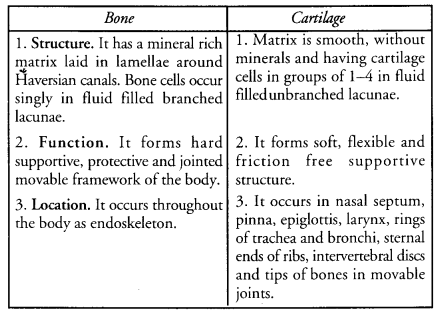
Question 46.
Name the tissue which helps in transportation of oxygen that we inhale to various parts of our body. Write the composition of this tissue. (CCE 2012)
Answer:
Blood Composition: Plasma or matrix – 55%, Blood cells – 45%. Plasma has 90 – 92% water, 8 – 10% organic and inorganic substances. Blood cells are of two types, haemoglobin containing red blood corpuscles (RBCs) and colourless white blood corpuscles (WBCs). Blood platelets are cell fragments present in blood.
Question 47.
Distinguish between tendon and ligament. Write one characteristic of each. (CCE 2012, 2013)
Answer:
Tendon is an inelastic cord of dense white connective tissue between muscle and bone while ligament is an elastic cord of dense yellow connective tissue between two bone ends.
Characteristic of Tendon: It contains parallel bands of white collagen fibres with rows of flat, elongated fibroblasts in between them.
Characteristic of Ligament: It has abundant yellow elastin fibres, bundles of white collagen fibres arranged variously and scattered fibroblasts.
Question 48.
Growth in plants is restricted to certain regions. Give reason for this fact. Mention two growth regions in plants.
(CCE 2012)
Answer:
In plants growth is restricted to certain regions because they are
(i) Attached, requiring supportive vertical tissue which is mostly made of dead cells,
(ii) Continued growth as older parts have to be shed or become dead since there is no regular excretory system.
- Apical meristem at tips of stem, root and their branches.
- Lateral meristem.
Question 49.
Name the hardest connective tissue you have studied. What is its function ? (CCE 2013)
Answer:
Bone: It forms supporting framework of body and protects vital organs like brain, heart and lungs.
Question 50.
What is cuboidal epithetial tissue ? What is its function ? (CCE 2013)
Answer:
Definition: It is an epithelial tissue which is made of compactly arranged cells which appear squarish in V.S. and polygonal in surface view.
Function: Stratified epithelium provides protection while simple one takes part in absorption, excretion, secretion and forming germinal layer.
Question 51.
Name the following tissues :
(a) Connective tissue found between skin and muscles.
(b) Tissue which connects two bones,
(e) Epithelial tissue which forms lining of kidney tubules,
(d) Tissue which is present in the veins of leaves.
(CCE 2013)
Answer:
(a) Areolar tissue
(b) Ligament
(c) Cuboidal epithelium
(d) Complex vascular tissue (xylem and phloem).
Question 52.
Give one word for
(a) Group of cells of similar structure and designed to give highest efficiency of function
(b) Process of taking up a permanent shape, size and function,
(c) Animal tissue connecting muscles to bones
(d) Kidney-shaped cells enclose stomata. (CCE2013, 2014)
Answer:
(a) Simple tissue
(b) Differentiation
(c) Tendon
(d) Guard cells.
Question 53.
Mention the differnt components of blood.
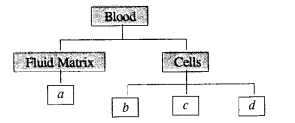
Answer:
a — plasma
b—red blood corpuscles (erythrocytes)
c—white blood carpuscles (leucocytes)
d—blood platelets (thrombocytes).
Question 54.
(a) On what basis is meristematic tissue classified ?
(b) Mention two characteristics of this tissue.
(c) Which amongst the meristems is called cambium ?
(CCE 2014, 2016)
Answer:
(a) On the basis of position —apical (tip of stem, root and their branches), intercalary (above or below nodes and leaf bases) and lateral (peripheral inside stem and root.
(b) Characteristics:
- Cells: Cells are small, spherical or polygonal with thin elastic wall.
- Intercellular Spaces: They are absent.
- Cell Contents: Nucleus is large. Cytoplasm is dense while vacuoles are absent.
- Activity: The cells have high anabolic rate. They grow and divide repeatedly.
(c) Cambium: Lateral meristem is called cambium. It is of two types, vascular cambium and cork cambium Gphellogen).
Question 55.
Which parts of our body are composed of nervous tissue ?
Name the cells that make up the nervous tissue.
(CCE 2012)
Answer:
(a) Brain, spinal cord and nerves are made of nervous tissue.
(b) Neurons or nerve cells constitute the nervous tissue
Question 56.
Write the location and function of collenchyma tissue in plants. (CCE 2014)
Answer:
Location: It occurs in hypodermis of herbaceous dicot stems, leaf midribs and leaf stalks.
Function: Collenchyma provides both mechanical strength and flexibility. Being living outer tissue. It may also help in photosynthesis and storage.
Question 57.
Draw diagram of phloem tissue and label on it all the three elements of phloem. (CCE 2014, 2016)
Answer:
Draw and label (except phloem fibre)
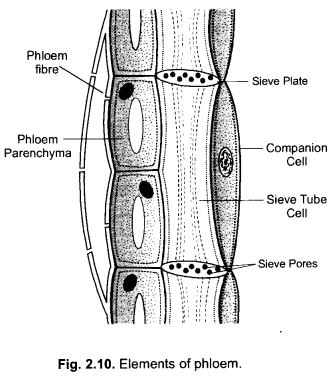
Question 58.
Name the type of tissue and its function present in the lining of kidney tubules. (CCE 2014)
Answer:
Epithelial cuboidal tissue. Secretion and absorption.
Question 59.
How is stratified squamous epithelium tissue different from simple squamous tissue ? (CCE 2015, 2016)
Answer:

Question 60.
Determine the location of the following tissues :
- Unstriated muscle fibres,
- Cuboidal epithelium.
- Adipose tissue,
- Striated muscle fibres.(CCE2015)
Answer:
- Unstriated Muscle Fibres: Inside visceral organs of the body like gastrointestinal tract, blood vessels, bronchi, urinary bladder, iris, etc.
- Cuboidal Epithelium: Germinal layer, kidney tubules, salivary mammary and pancreatic ducts, thyroid vesicles,
Function: Gametes from germinal epithelium. - Adipose Tissue: Below skin, cushion around heart, kidneys, eye ball, in between body organs.
- Striated Muscle Fibres: In limbs attached to bones, neck, face, bodywall, tongue, pharynx, diaphragm, upper part of oesophagus.
Question 61.
Give one word for the following :
- Group of cells with similar structure and designed to give highest efficiency of function,
- The process of taking up permanent shape, size and function,
- Animal tissue connecting muscle to bones,
- Kidney shaped cells that enclose stomata. (CCE 2015)
Answer:
- Tissue
- Differentiation
- Tendon
- Guard cells.
Question 62.
Name the muscular tissue which is present in the iris of the eye. What is the shape of these cells ? (CCE 2016) ;
Answer:
Smooth or unstriated muscle fibres. Spindle shaped. :
Question 63.
Write the names of connective tissues—a, b, c and d.

Answer:
a— blood,
b—areolar tissue,
c—ligament,
d-—tendon.
Question 64.
Mention the different components of blood in the following | diagram

Answer:
a— plasma,
b—erythrocytes,
c—leucocytes,
d—blood platelets.
Question 65.
Differentiate between simple tissue and complex tissues in
Answer:
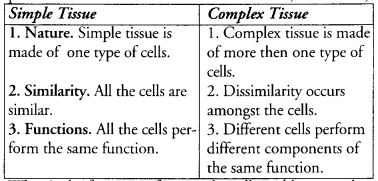
Question 66.
What is the function of sieve tube cells and how are they ! designed to carry out their function ? (CCE 2016)
Answer:
Function. Translocation of food (organic nutrients).
Design. The cells are vacuolate, nonnucleate and placed end to end in the form of tube called sieve tube. The septa between the sieve tube cells are porous (called sieve plates) for rapid transport.
Question 67.
Name the tissue in animals that carries out similar function as the following tissues do in plants :
(i) Epidermis
(ii) Vascular bundles. Also write their function.
(CCE 2016)
Answer:
(i) Epidermis: Epithelium in animals. Function. Protection from drying up, microbes, chemicals and injury.
(ii) Vascular Bundles: Blood vascular system. Function, Translocation of materials from source to individual cells and passage of materials given out by cells to the place of disposal.
Short Answer Questions (3 marks)
Question 1.
In the given figure
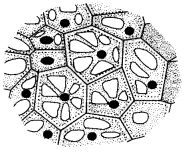
(a) Identify the tissue,
(b) In-fer the characteristic features of these cells,
(c) Suggest any two parts of the plant where such cells are present.
(CCE 2010)
Answer:
(a) Parenchyma.
(b) Characteristics.
- Thin-walled living cells.
- The cells have a large central vacuole and a peripheral cytoplasm which sends strands into the central vacuole.
(c) Location.
- Cortex and pith of stem and root.
- Major part ofleaves, flowers and fruits.
Question 2.
(a) Draw a labelled diagram of a neuron with three/four labellings.
(b) Identify the tissue which is made of these cells.
(c) Name one organ which is made of this tissue.
(CCE 2010, 2011, 2012, 2015)
Answer:
(a)
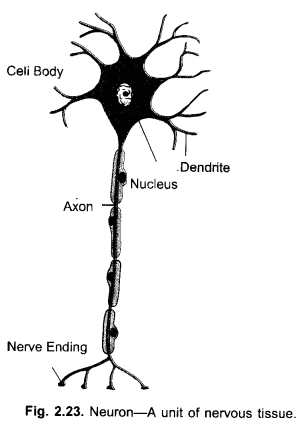
(b) Nervous tissue,
(c) Brain.
Question 3.
Observe the given figure
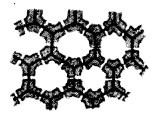
(a) Identify the tissue,
(b) Infer the charac-teristic features of these cells.
(c) Specify any two parts of the plant where such cells are present.
(CCE 2010, 2011)
Answer:
(a) Sclerenchyma.
(b) Features
- Thick walled cells,
- Empty dead cells,
- No intercellular spaces.
(c) Location
- Hypodermis of monocot stems,
- Around the vascular bundles and inside the vascular tissues.
Question 4.
(a) Draw adipose connective tissue.
(b) Mention one region of the body where this tissue is present and state one function of this tissue. (CCE 2010, 2012)
Answer:
(a)
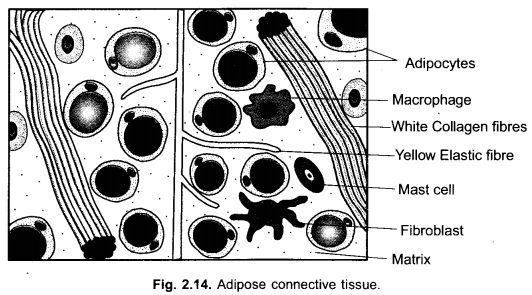
(b)
- Location: Subcutaneous region of the body,
- Function: Insulation.
Question 5.
Name the tissue responsible for flexibility in plants. How would you differentiate it from other permanent tissues ?
(CCE 2010, 2011)
Answer:
Collenchyma provides flexibility in plants.
Collenchyma differs from other permanent tissues in having irregular wall thickenings, generally at the corners.
Question 6.
(a) Draw labelled diagram of striated muscles.
(b) Mention any two characteristic features of the cells that form the above muscular tissue. (CCE 2010, 2011)
Answer:
(a)
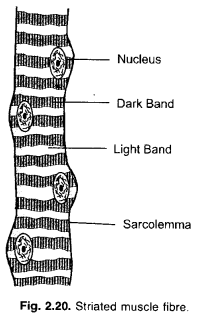
(b) Features:
- Presence of light and dark bands,
- Several oval nuclei present peripherally.
Question 7.
What is connective tissue ? State its any two basic components. Differentiate between ligament and tendon.
(CCE 2010, 2011)
Answer:
Connective Tissue: It is a fundamental animal tissue having abundant matrix with scattered living cells that takes part in connecting, binding, packing and supporting different structures of animal body.
Basic Components
(i) Abundant matrix
(ii) Scattered living cells.
Differences between Ligament and Tendon
| Tendon | Ligament |
| 1. Nature. It is tough and inelastic.
2. White Fibres. Tendon contains parallel bundles aof white collagen fibres. 3. Yellow Fibres. Yellow elastin fibres are absent. 4. Fibroblasts. They occur in rows. 5. Function. It connects a muscle to a bone. |
It is strong but elastic.
Bundles of white collagen fibres are arranged in various directions. Yellow elastin fibres occur in good number. Fibroblasts lie scattered. It joins a bone with another bone. |
Question 8.
(a) Identify the given figures.
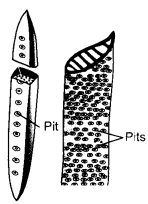
(b) State in brief their structure,
(c) Describe the role performed by the two.
(CCE2010, 2011)
Answer:
(a) Tracheid, vessel.
(b) Tracheid. It is an elongated lignified dead cell with wide lumen and pointed end walls.
Vessel: It is a long multicellular tubular structure having many short lignified dead cells with wide lumen and broad rup¬tured end walls arranged in a linear sequence.
Role: Both tracheids and vessels take part in transport of sap (water and mineral salts) alongwith providing mechanical strength.
Question 9.
List any six characteristics of parenchyma tissue.
(CCE2010, 2011, 2012, 2013)
Answer:
- Type: k is a living, simple permanent tissue.
- Cell Walls: The cell wall is thin and unlignified.
- Cell Shape: Cells are isodiamatric, oval, rounded or po-lygonal.
- Intercellular Spaces: Intercellular spaces are abundant so that cells are loosely packed.
- Storage: The tissue stores nutrients and water in its cells.
- Modifications: The tissue gets modified to form epidermis, chlorenchyma and aerenchyma.
Question 10.
From the accompanying diagram
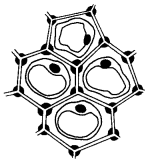
(a) Identify the tissue
(b) Infer the characteristic features of these cells.
(c) Specify the function of the tissue
(d) Name any part of the plant where these cells are present.
(CCE2010, 2011, 2012)
Answer:
(a) Collenchyma
(b)
- Irregular Thickening: Cells possess irregular wall thickenings, generally at the corners,
- Intercellar Spaces:They are absent.
- Living Simple Tissue: It is living simple tissue having large central vacuoles in its cells.
(c) Function: The tissue provides both flexibility and me-chanical strength.
(d) Location: It occurs in hypodermis of herbaceous dicot stems, leaf stalks and leaf midrib.
Question 11.
(a) Name the following structures of a neuron :
- Single long part which arises from cell body
- Part of neuron which bears many short branched parts.
(b) What is nerve ?
(c) Name two involuntary muscles.
(CCE2010, 2011)
Answer:
(a)
- Axon
- Cell body bearing dendrons and dendrites.
(b) Nerve: It is a fibrous structure formed by aggregation and linking of neurons or nerve cells that transmits electrical sig-nals between central nervous system and body tissues.
(c) Involuntary Muscles:
- Smooth or unstriated muscles
- Cardiac muscles.
Question 12.
How is meristematic tissue classified on the basis of its loca¬tion ? Draw a well labelled diagram to show the location of meristematic tissue in the plant body. (CCE 2010)
Answer:
On the basis of location, meristematic tissue or meristem is of three types – apical, intercalary and lateral.

Question 13.
Which permanent tissue
(a) Forms husk of coconut
(b) Stores nutrients and water in stems and roots
(c) Is irregularly thickened at the corners. (CCE 2010)
Answer:
(a) Sclerenchyma
(b) Parenchyma
(c) Collenchyma.
Question 14.
Give the location and function of the following tissues :
(a) Cartilage
(b) Areolar tissue
(c) Adipose tissue.
(CCE 2011, 2012, 2013)
Answer:
(a) Cartilage:
- Location: Nose, ear, trachea, bronchi, larynx, bone ends.
- Function: Providing support and elasticity to nose, ear, trachea, bronchi, larynx. Smoothening and protecting bone ends at the joints.
(b) Areolar Tissue:
- Location: Subcutaneous tissue between skin and muscles, inside bone marrow, binding packing and covering tissue of various body organs including blood vessels and nerves.
- Function: Binding, packing and covering of body organs, and providing materials for repair of injuries.
(c) Adipose Tissue:
- Location: Below skin, cushion around heart, kidneys, eye ball, in between body organs.
- Function: Storage of fat, shock absorption and insulation.
Question 15.
Give one reson for the following statements :
(a) Blood is called connective tissue.
(b) Muscles are able to contract and relax to bring about movements
(c) Muscles of heart are called involuntary muscles.
(CCE 2011)
Answer:
(a) Blood:
- Like other connective tissues, blood consists of living cells scattered in an abundant matrix. The matrix is liquid or plasma in blood.
- Blood circulates throughout the body, receiving and providing materials to all tissues and organs of the body. It thus connects all parts of the body.
(b) Muscles: Muscles possess contractile myofibrils made of protein filaments. Their contraction and relaxation produce movements.
(c) Muscles of Heart: They show rhythmic contraction and relaxation throughout life. They are not under the control of will.
Question 16.
(a) Name the connective tissue that is found between skin and muscles.
(b) Draw its diagram and label any three parts.
(CCE 2011, 2012)
Answer:
(a) Areolar tissue.
(b)
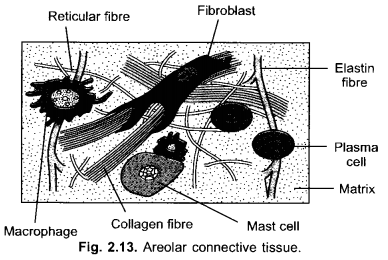
Question 17.
Show the diagrammatic representation of the location of intercalary meristem and lateral meristem in plant. Name the meristem which is responsible for increase in girth of root. (CCE 2011 )
Answer:
(a)
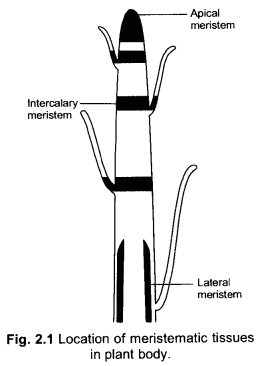
(b) Lateral meristem
Question 18.
Define the term tissue. Differentiate between simple and permanent tissues in plants. Name the tissue which
(a) allows aquatic plants to float
(b) provides flexibility to plants.
(CCE 2011)
Answer:
Tissue: Tissue is a group of related cells that have a common origin and perform a common function.
Differences:
| Simple Tissues | Complex Tissues |
| 1. Cells: A simple tissue is formed of only one type of cells. | A complex tissue is made of more than one type of cells. |
| 2. Activity: All the cells perform the same function. | The different cells perform different fractions of a function. |
| 3. Types: There are three types of simple plant tissues— . parenchyma, collenchyma and sclerenchyma. | There are two types of complex plant tissues— xylem and phloem. |
| 4. Function: They form primary structure of the plant. | They form transport system of the plant. |
(a) Tissue for Floating: Aerenchyma
(b) Tissue for Flexibility: Collenchyma.
Question 19.
(a) Explain how bark/cork of a tree is formed.
(b) How does it act as protective tissue ?
(CCE 2011, 2012)
Answer:
(a) Bark is the outer dead tissue. It is mostly made of cork. It develops from outer secondary lateral meristem called phellogen or cork cambium. Cells formed on the outer side become suberised, dead and filled with tannin. They constitute cork. Cork is compact and several layers in thickness. Its outer part cracks and peels off at times.
(b) Function As Protective Tissue:
- Bark is made of compact, dead, ’empty’, impermeable, tannin and resin containing cells which repel microbes and animals,
- It is water proof
- It is shock proof,
- It provides insulation.
Question 20.
(a) Name the liquid matrix of blood,
(b) What does it contain ?
(c) List any two functions of blood.
(CCE 2011, 2012)
Answer:
(a) Plasma.
(b) It consists of water (92%), salts, proteins, nutrients (glucose, amino acids, fatty acids, vitamins), hormones and excretory products,
(c) Functions.
- Transport of gases, nutrients, hormones and waste materials,
- Distribution of heat.
Question 21.
Mention the type of tissue which
(a) Enables the plant to transport food materials from leaves to other parts of its body.
(b) Helps in the growth of girth of stem,
(c) Helps in the transport of water from root to other parts.
(d) Provides support to plants and also stores food.
(CCE 2011)
Answer:
(a) Phloem
(b) Lateral meristem (cambium)
(c) Xylem
(d) Parenchyma.
Question 22.
Draw the diagram of smooth muscle and cardiac muscle and label the parts. (CCE 2011)
Answer:
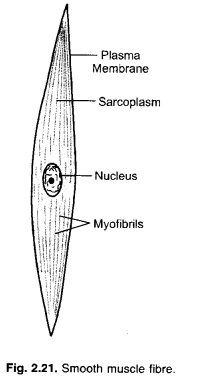
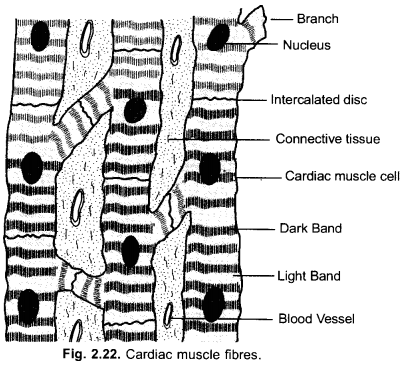
Question 23.
- What type of tissue is bone ?
- What is hard matrix made of ?
- Write the function of ligaments and tendon.
(CCE 2011)
Answer:
- Bone is a skeletal connective tissue
- Calcium and magnesium carbonate and phosphate
- Ligament connects two bones while tendon connects a muscle to a bone.
Question 24.
Why is parenchyma called a permanent tissue ? Name two special types of parenchyma. Mention their specific roles in plants. (CCE 2011)
Answer:
Parenchyma is called permanent tissue as its cells are mature, unable to divide and have attained a permanent shape, size and function.
- Chlorenchyma. Manufacture of food
- Aerenchyma. Buoyancy to aquatic plants.
Question 25.
(a) Draw diagram of a muscle. Label in it
- Spindle shaped nucleus
- Striation
(b) List any two characteristics of this muscle. (CCE 2011)
Answer:
(a)
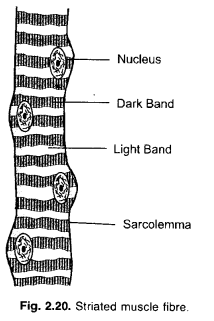
(b) Characteristics,
- Long cylindrical cells with blunt ends,
- Many peripheral nuclei.
Question 26.
What is meristematic tissue ? State its different types. Show their location in a diagram of a plant body. (CCE 2011)
Answer:
Meristematic tissue is a tissue of small thin-walled immature cells that have the ability to divide and form new cells. Location wise there are three types of meristematic tissues or meristams-apical, intercalary and lateral.
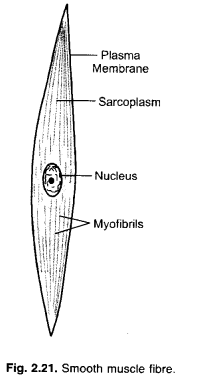
Question 27.
(a) Name the fat storing tissue of our body.
(b) Describe its structure and function with the help of a diagram. (CCE 2011, 2013)
Answer:
(a) Adipose tissue.
(b) Structure. It is a connective tissue in which there are large fat storing cells or adipocytes. Matrix is jelly like. Fibres and cells of connective tissue are also present.
Function:
- Storage of fat.
- Adipose tissue functions as a cushion around vital organs. It acts as an insulator.
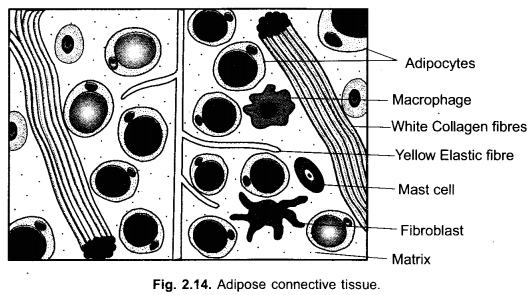
Question 28.
What are the three main functions of areolar tissue ?
(CCE 2011, 2013)
Answer:
- Packing of organs
- Covering of organs
- Providing materials for repair of injury.
Question 29.
Make a table to show the differences between striated, unstriated and cardiac muscles on the basis of their structure and location in the body. (CCE 2011)
Answer:

Question 30.
Write one function of each of the following tissues and also name the chemicals present in them :
(a) Sclerenchyma
(b) Collenchyma
(c) Cork cells. (CCE 2011)
Answer:
(a) Sclerenchyma. Function. Providing mechanical strength. Chemical. Lignin.
(b) Collenchyma. Function. Providing strength with flexibility. Chemical. Pectocellulose.
(c) Cork Cells. Function. Protection of internal plant tissues. Chemical. Suberin (with tannin and resin).
Question 31.
Write the term for the following tissues :
(a) That joins muscle to bone
(b) Fat reservoir of our body
(c) Supporting, filling the space inside the organs and helps in repair of tissues. (CCE 2012)
Answer:
(a) Tendon
(b) Adipose tissue
(c) Areolar tissue.
Question 32.
Label the figure and give one function of each part labelled a, b and c.(CCE 2012, 2013)
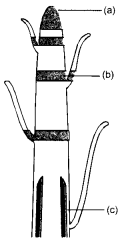
Answer:
a. Apical Meristem: Growth in length.
b. Intercalary Meristem: Growth in intenodes and leaves, bending of lodged shoots.
c. Lateral Meristem: Growth in girth.
Question 33.
(a) State one point of difference between xylem and phloem,
(b) Draw a neat diagram of xylem vessel and a tracheid. (CCE 2012)
Answer:
(a) Xylem takes part in translocation of sap (water and minerals) while phloem translocates food materials in the plant.
(b) Draw a labelled diagram given in question 8 above.
Question 34.
(a) Draw a labelled diagram of a tissue that transmits stimulus in our body,
(b) How does this tissue enables animals to move rapidly in response to stimuli ?
Answer:
(a)
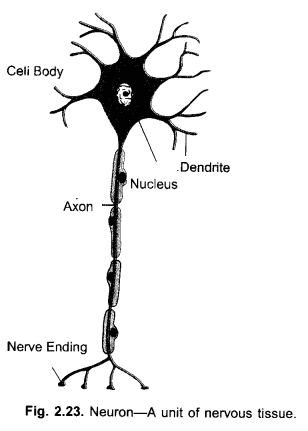
(b) Nervous system is specialised to receive stimulus and provide a response to the same by activating skeletal muscles to perform the quick movements.
Question 35.
(a) Uma started walking fast when she noticed that some unknown faces are following her. Name the type of tissues which facilitated the movement of her leg bones in response to the stimulus.
(b) Draw diagram of any of the above mentioned two tissues and label any two parts.
Answer:
(a) Striated muscles and tendons, ligaments.
(b)
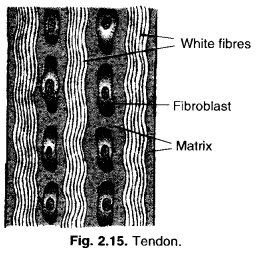

Question 36.
State one distinguishing feature and one similarity between two types of transporting tissues in plants. (CCE 2012)
Answer:
Transporting Tissues : Xylem (transports water and minerals) and phloem (transports food or nutrients). Similarity. Both are complex tissue, each made up of four types of cells.
Dissimilarity: Conducting channels of phloem or sieve tubes are made of living cells while conducting channels of xylem or tracheids and vessels are made of dead and empty cells.
Question 37.
Identify the simple permanent tissue and mention the location :
(a) Cells have irregular wall thickenings
(b) Tissue with large air cavity
(c) Cells are long, narrow and dead.
(CCE 2012)
Answer:
(a) Collenchyma: Hypodermis of herbaceous dicot stems, leaf stalks and leaf midrib.
(b) Aerenchyma: Stems, leaves and roots of aquatic plants.
(c) Sclerenchyma: Hypodermis of monocot stem, bundle caps, around and inside vascular bundles.
Question 38.
Identify the animal tissues from the given description and also mention their location in the human body. Tissue a. Cells are filled with fat globules and the tissue acts as an insulator. Tissue b. Has cylindrical branched cells and the tissue shows rhythmic contraction and relaxation throughout life. (CCE 2012)
Answer:
(a) Adipose Tissue: Below skin and around important organs.
(b) Cardiac Muscles: Wall of heart.
Question 39.
Write the location and one function of each
(a) Cuboidal epithelium
(b) Glandular epithelium
(c) Columnar epithelium. (CCE 2012)
Answer:
(a) Cuboidal Epithelium :
- Location: Germinal layer, kidney tubules, salivary mammary and pancreatic ducts, thyroid vesicles,
- Function: Gametes from germinal epithelium.
(b) Glandular Epithelium :
- Location: Skin (sweat and oil glands), alimentary canal (digestive glands),
- Function: Secretion of enzymes and excretion of wastes.
(c) Columnar Epithelium :
- Location: Lining of stomach and intestine,
- Function: Absorption in intestine.
Question 40.
Mention three characteristic features and three functions of xylem. (CCE 2012, 2013)
Answer:
Characteristic features,
- It consists of four types of elements—tracheids, vessels, xylem parenchyma and xylem fibres.
- Only xylem parenchyma is living. The other three are dead and lignified.
- Tracheids and vessels are tracheary elements for which they have wide lumen and thin areas at places.
Functions,
- Xylem conducts sap (water and mineral salts) through its tracheary elements,
- It provides mechanical strength to the plant.
- Xylem parenchyma stores food and helps in sideways conduction of water.
Question 41.
Show the diagrammatic representation of the location of intercalary meristem and lateral meristem in plant. Name the meristem which is responsible for
- Increase in girth of root
- Increase in length of roots. (CCE 2012)
Answer:
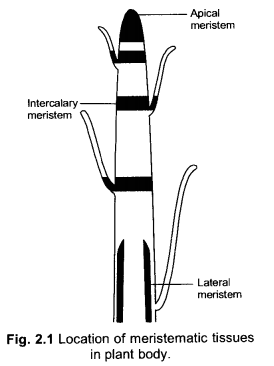
Label the two meristems.
- Lateral meristem
- Apical meristems.
Question 42.
Explain in brief any three roles of epidermis in plants.
(CCE 2012)
Answer:
- Protection: Epidermis, being outer covering, protects the internal structures and prevents the entry of pathogens ‘ and pests.
- Water Loss: Cuticular covering of epidermis reduces the rate of water loss from exposed surface.
- Stomata: Stomata present in the epidermis regulate gaseous exchange and transpiration.
Question 43.
Make a labelled diagram to highlight two differences between striated and cardiac muscles. Write one function of striated muscles in our body. (CCE 2012)
Answer:
(a)
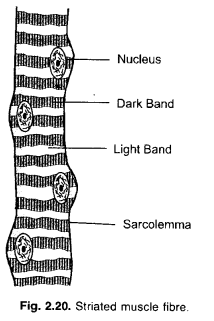
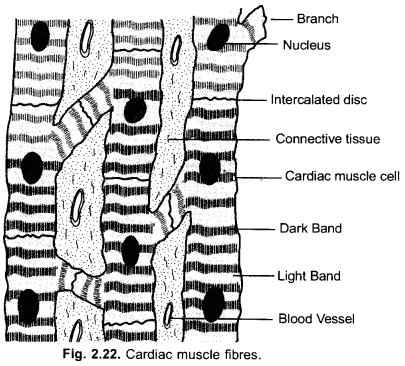
(b) Striated muscles being voluntary and attached to bones help in voluntary body movements including locomotion
Question 44.
Complete the following flow chart
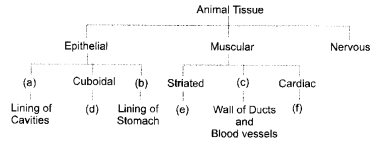
Answer:
(a) Squamous
(b) Columnar
(c) Smooth
(d) Kidney tubules and ducts of salivary glands
(e) Attached to bones
(f) Wall of heart.
Question 45.
Name any three connective tissues. Give any one function of each. (CCE 2012)
Answer:
- Areolar Tissue: Packing, binding, covering and repair.
- Bone: Bony endoskeleton forms supportive framework of body.
- Blood: It transports nutrients, metabolic wastes, gases and hormones from one part to another inside the body.
Question 46.
Name the type of epithelial tissue that lines
- Oesophagus
- Respiratory tract
- Kidney tubules
- Inner lining of intestine
- Blood vessels
- Ducts of salivary glands. (CCE 2012)
Answer:
- Stratified squamous epithelium
- Ciliated columnar epithelium
- Cuboidal epithelium
- Columnar epithelium
- Squamous epithelium
- Cuboidal epithelium.
Question 47.
(i) Draw a labelled diagram of longitudinal section of sclerenchyma
(ii) Name any two regions in the plant where this tissue is present. (CCE 2012)
Answer:
(i)
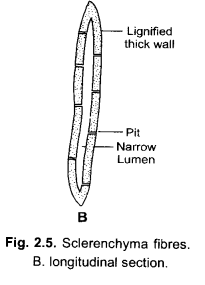
(ii) Hypodermis of monocot stem, bundle cap of young dicot stem, around and inside vascular bundles.
Question 48.
(a) Name four different types of epithelial tissue,
(b) List two functions of epithelial tissue. (CCE 2012)
Answer:
(a) Squamous, cuboidal, columnar, glandular.
(b)
- Protection: Surface epithelium present over skin and lining of mouth protects the underlying tissues from chemicals, injury and desiccation,
- Secretion: Glandular epithelium produces secretions like tears, mucus, gastric, juice, intestinal juice, etc.
Question 49.
Name and differentiate the type of meristematic tissues on the basis of their function. (CCE 2012)
Answer:
- Growth in length of stem and root – apical meristem.
- Growth in internodes and leaves – intercalary meristem.
- Growth in girth of stem and root – lateral meristem.
Question 50.
(a) Write two differences between tendon and ligament.
(b) List any two regions of the body where cartilage is present. (CCE 2012)
Answer:
(a)
| Tendon | Ligament |
| 1. Nature. It is tough and inelastic.
2. White Fibres. Tendon contains parallel bundles aof white collagen fibres. 3. Yellow Fibres. Yellow elastin fibres are absent. 4. Fibroblasts. They occur in rows. 5. Function. It connects a muscle to a bone. |
It is strong but elastic.
Bundles of white collagen fibres are arranged in various directions. Yellow elastin fibres occur in good number. Fibroblasts lie scattered. It joins a bone with another bone. |
(b) Tip of nose, pinna.
Question 51.
(a) Which element of phloem comprises dead cells ?
(b) Give one function each of tracheids and vessels and xylem parenchyma,
(c) Draw a diagram of xylem
parenchyma and label nucleus. (CCE 2012)
Answer:
(a) Phloem or bast fibres,
(b)
- Tracheids and vessels – transport of sap
- Xylem parenchyma – lateral transport of sap.
(c)
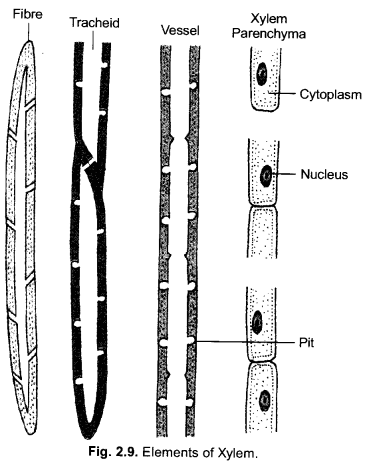
Question 52.
Write difference amongst striated muscles, smooth muscles and cardiac muscles on the basis of their shape and number of nuclei?
Answer:
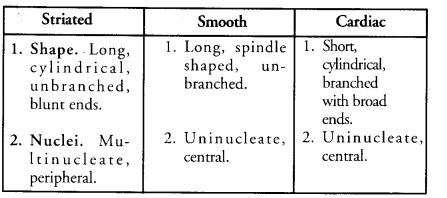
Question 53.
Name the plant tissue which is associated with the conduction of water in the plant body. Why is this tissue called complex tissue, (CCE 2012)
Answer:
- Xylem.
- Xylem is called complex tissue because it is made of more than one type of cells.
- Components: Tracheids, vessels, xylem fibres and xylem parenchyma.
Question 54.
List three differences between striated/limb muscles and smooth/stomach muscles. (CCE 2012, 2013)
Answer:
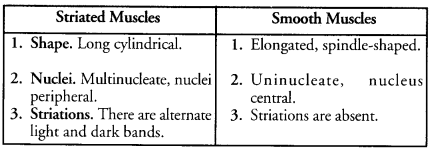
Question 55.
(a) Why are complex tissues called so ?
(b) Write names of complex tissues.
(c) State the functions of these tissues.
(CCE 2013)
Answer:
(a) Complex Tissues. They are permanent plant tissues which are made of more than one type of cells which work together to perform a particular function,
(b) There are two types of complex tissues, xylem and pholem.
Functions:
- Transport of sap (water + minerals).
- Translocation of food.
Question 56.
Draw a diagram of smooth muscle fibre and label any three parts. Give one function of smooth muscles.
(CCE 2013)
Answer:
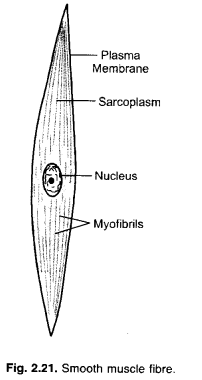
Function: Sustained involuntary contraction activity as in peristalsis.
Question 57.
(a) Name the tissue which joins :
(i) Muscle to bones
(ii) Bones to bones
(b) Which of the two is
(i) More elastic
(ii) Stronger ? (CCE 2013)
Answer:
(a) (i) Tendon
(ii) Ligament
(b) (i) Ligament
(ii) Tendon.
Question 58.
Animal tissues are different from plant tissues. State reason.
(CCE 2013, 2014)
Answer:
- Mobility: Plants are stationary. They have more of dead supportive tissues for mechanical strength. Animals are mobile. Most of their tissues are living, requiring more energy for maintenance.
- Growth: Plants continue to grow throughout life while animals stop growing after becoming mature. Plants have meristematic tissue which is absent in animals.
- Structural Organisation: Animals have more complex strucmral organisation due to higher level of specialisation.
Plants have simpler organisation.
Question 59.
Write one term for the following tissues
(a) that joins muscle to bone
(b) fat reservoir of our body
(c) supporting, fills the space inside the organs and helps in repair of tissues. (CCE 2013)
Answer:
(a) Tendon
(b) Adipose tissue
(c) Areolar tissue.
Question 60.
Name the tissue found in the following locations,
(a) Haversian canal
(b) Chondrocyte
(c) Eosinophils. Give one function of each of these. (CCE 2013, 2015)
Answer:
(a) Haversian Canal. Bone. Forms supporting framework of body.
(b) Chondrocyte. Cartilage. Support with flexibility (as in pinna).
(c) Eosinophils. Blood. Transport of nutrients, metabolic j wastes, gases, hormones, etc.
Question 61.
Draw a well labelled diagram of phloem tissue.
(CCE 2013)
Answer:
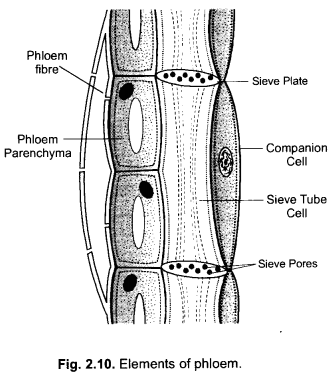
Question 62.
Name the following and give one characteristic of each :
(a) Living tissue that provides mechanical support in plants.
(b) Highly specialised cells for being stimulated and then transmitting the stimulus very rapidly within the body of animais,
(c) Animal tissue with elongated cells and contractile proteins responsible for movement. (CCE 2013, 2015)
Answer:
(a) Collenchyma: Irregular thickening of pectocellulose generally at the corners.
(b) Neurons: Tree-like branching, have cell body with dendrites, axon with terminal arborisations,
(c) Muscle fibre: Cylindrical multinucleate cells with light and dark bands.
Question 63.
Name the permanent tissue which
(a) Forms husk of coconut
(b) Gives flexibility to the plant,
(c) Are loosely packed cells with presence of chlorophyll. (CCE 2013)
Answer:
(a) Sclerenchyma
(b) Collenchyma
(c) Chlorenchyma.
Question 64.
(a) Name the muscle :
(i) Which is present exclusively in the heart
(ii) Which is attached to the bones and helps in voluntary movement. )
(b) Write the structural differences between them
(c) Draw their neat and labelled diagram. (CCE 2013)
Answer:
(a)
(i) Cardiac
(ii) Striated or skeletal
(b)

(c)
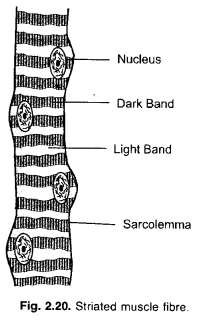
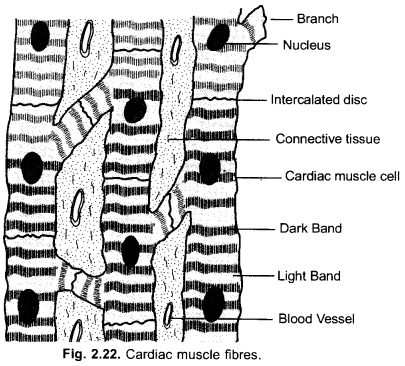
Question 65.
Identify the type of tissues in the following :
(a) Vascular bundle
(b) Inner lining of intestine
(c) Lining of kidney tubule
(d) Iris of eye
(e) Muscles of heart
(f) Bronchi of lungs. (CCE 2013)
Answer:
(a) Vascular tissues, xylem and phloem.
(b) Columnar epithelium
(c) Cuboidal epithelium
(d) Smooth muscle
(e) Cardiac muscle
(f) Smooth muscles, cartilage, ciliated columnar epithelium.
Question 66.
(a) Why do sclerenchyma cells have a narrow lumen ?
(b) Where are these tissues present and why ?
(CCE 2014)
Answer:
(a) Due to excessive thickening and lignification of wall and degeneration of protoplasmic contents.
(b) Sclerenchyma occurs as hypodermis in monocot stem, around vascular bundles, inside vascular tissues, hard covering of seeds, etc., for mechanical strength and protection.
Question 67.
(d) Mention different types of blood cells.
(b) Which substances are transported by blood.
(CCE 2014)
Answer:
(a) Blood Cells. Three types.
- Biconcave enucleate coloured red blood corpuscles (erythrocytes, RBCs).
- Nucleated, colourless, white blood corpuscles capable of changing shape (leucocytes, WBCs).
- Nonnucleated small colourless cell fragments called blood platelets.
(b) Transport. Blood transports nutrients (e.g., glucose, amino acids, fatty acids), metabolic gases (02, C02), metabolic wastes (e.g., urea, uric acid), hormones, etc.
Question 68.
Differentiate between xylem and phloem tissues.
(CCE 2014, 2016)
Answer:
| Xylem | Phloem |
| I. Conduction. It conducts water and minerals. | Phloem conducts organic solutes or food materials. |
| 2. Direction. Conduction is mostly unidirectional. | Conduction can be bidirectional. |
| 3. Channels. Conducting channels or tracheary elements are tracheids and vessels. | Conducting channels are sieve tubes. |
| 4. Components. Xylem consists of tracheids, vessels,xylem parenchyma and xylem fibres. | Phloem consists of sieve tubes, companion cells, phloem parenchyma and phloem fibres. |
| 5. Dead/Living Parts. Three of the four elements of xylem are dead (viz., tracheids, vessels and fibres). Only xylem parenchyma is living. |
Three of the four elements are living (viz., sieve tubes,companion cells and phloem parenchyma). Only phloem/fibres are dead. |
| 6. Mechanical Strength. In addition to conduction, xylem provides mechanical strength to the plant. | There is little mechanical function of phloem. |
Question 69.
Establish the relationship between the structure, function and location in each case :
(a) Bone
(b) Areolar tissue
(c) Striated muscle. (CCE 2014, 2015)
Answer:
(a) Bone
- Structure: It is hard connective tissue having a matrix of collagenous protein ossein and mineral matter, mostly of calcium and phosphorus laid down in lamellae around Haversian canals, Living osteocytes are stellate and occur in branched fluid-filled lacunae.
- Function: Framework of body, movement and protection to vital organs.
- Location: Inside the body as endoskeleton.
(b) Areolar Tissue: It is a simple connective tissue that possesses a jelly-like matrix, both white and yellow elastin fibres, fibroblasts, mast cells, plasma cells, macrophages and immunocytes.
Location: Inside and outside organs and tissues and as subcutaneous tissue.
Functions:
- Binding: Packing and Covering. Areolar tissue functions as binding, packing and covering tissue around and inside various body organs,
- Repair: Areolar tissue provides materials for repair of injuries.
(c) Striated Muscle:
- Structure: Long, cylindrical cells with alternate light and dark bands and many oval peripheral nuclei,
- Function: Voluntary body movements including locomotion.
- Location: In limbs attached to bones, neck, face, bodywall, tongue, pharynx, diaphragm, upper part of oesophagus.
Question 70.
State the location and function of columnar epithelium. When and how is it modified ? Write the function of this modified tissue. (CCE 2014)
Answer:
(a) Location: Lining of stomach and intestine,
Function: Absorption in intestine.
(b) Modification
(i) Microvilli or tiny finger like projections on free surface (as in intestine) for increasing absorptive surface
(it) Cilia in respiratory tract and oviducts for producing slow pushing of materials.
Question 71.
Differentiate between different types of simple permanent tissues.
Answer:

Question 72.
Write two similarities and four differences between striated and cardiac muscles. (CCE 2014)
Answer:
(a) Similarities.
(i) Both are cylindrical cells with broad ends,
(ii) They contain striations or alternate light and dark bands.
(b) Differences
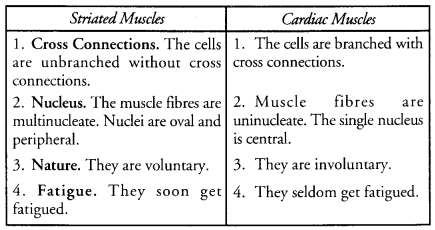
Question 73.
Differentiate between bone and cartilage with respect to structure, function and location. (CCE 2014)
Answer:
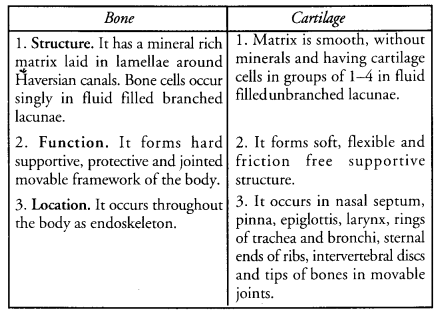
Question 74.
Classify permanent tissues in plants. (CCE 2014)
Answer:
Permanent tissues are of two types, simple (three in number)and complex (two in number).
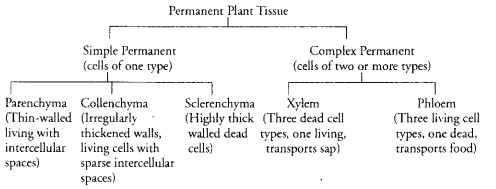
Question 75.
Describe the structure, function and location of nervous tissue. (CCE 2014)
Answer:
Structure: Nervous tissue consists of neurons or nerve cells surrounded by special connective tissue cells. Each neuron consists of a nucleated cell body, small branched afferent dendrites and a long fibre-like efferent axon with terminal branches having knobs or boutons.
Function: Nervous tissues is specialised to pick up sensations, rapidly transmit the impulses, integrate and respond to the same.
Location: It occurs in brain, spinal cord and nerves.
Question 76.
Write six functions of the epithelial tissue.
(CCE 2015)
Answer:
- Protection of underlying tissues from drying up, microbes, chemicals and injury.
- Absorption in intestine.
- Excretion in uriniferous tubules.
- Exchange of gases in alveoli
- Secretion by glandular epithelium.
- Formation of gametes by germinal epithelium.
Question 77.
Explain the basic characteristics for classification of permanent tissues in plants. (CCE 2015, 2016)
Answer:
Basic characteristics for classification of permanent tissues are simple or complex nature and types of their specialisation. Simple Permanent Tissues. The tissues are made up of one type of cells. Depending upon their living or dead nature and thickening, simple permanent tissues are of 3 types :
- Parenchyma: Thin walled, living.
- Collenchyma: Uneven thickening of pectocellulose, living.
- Sclerenchyma: Thick walled, lignified, dead.
Complex Permanent Tissues. The tissues are made up of more than one type of cells. They are of two types.
- Xylem: Consists of tracheids, vessels, fibres and parenchyma,
- Phloem: Consists of sieve tubes, companion cells, parenchyma and fibres.
Question 78.
- What type of tissue is blood ?
- What are the types of muscle fibres ?
- Write the functions of ligaments and tendons. (CCE 2015)
Answer:
- Connective tissue,
- Unstriped (smooth), striped (striated) and cardiac,
- Ligament: Connecting bone to bone and allowing movement including rotational. Tendon. Connecting muscle to bone for body movements.
Question 79.
Give one important functional difference amongst the muscle tissues and draw a labelled diagram of the muscle tissue which never shows fatigue. (CCE 2015)
Answer:
- Muscle tissues are of three types – striated, smooth and cardiac.
- Striated (= skeletal) muscle brings about voluntary movements of body parts, e.g., movement of arms.
- Smooth (Unstriated) muscle performs involuntary movements like peristalsis for passage of food in the alimentary canal.
- Cardiac muscle performs involuntary non-fatigued movement of heart in pumping blood to all body parts.
Question 80.
Complete the following flow diagram : (CCE 2015)
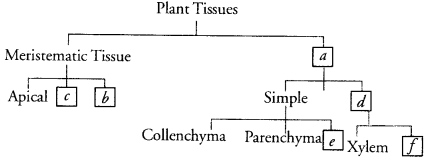
Answer:
a – Permanent tissue.
b – Intercalary
c – Lateral
d – Complex
e – Sderenchyma
f – Phloem.
Question 81.
(a) Name the animal tissue which is present in the larynx,
(b) Write the chemical constituents of this tissue,
(c) What function does this tissue perform ? (CCE 2016)
Answer:
(a) Tissue Present in Larynx. Cartilage,
(b) Chemical Constituents. Its matrix is made of protein sugar complex called chondrin.
(c) Function. Providing both support and flexibility besides showing little wear and tear.
Question 82.
State the location and function of columnar epithelium. Where and how is it modified ? Write the function of this modified tissue. (CCE 2016)
Answer:
Location: Simple columnar epithelium occurs in the lining layer of stomach, intestine and their glands. Modified columnar epithelium called pseuddstratified epithelium occurs in the nasal and genital tracts. Stratified columnar epithelium forms covering layer of epiglottis.
Functions:
- Absorption: As lining layer of intestine, columnar epithelium is specialised to absorb nutrients.
- Mucus: Goblet cells, which are modfied columnar cells, produce mucus.
- Glandular Epithelium: It is a component of most glandular epithelia.
- Protection: Being a surface layer, it provides protection to underlying tissues.
Question 83.
(a) Name the following tissues :
(i) The tissue which gives flexibility to plants,
(ii) Tissue which gives support to the plants and also stores food.
(b) Write two structural differences between the above two tissues.
(c) In desert plants the epidermis has a thick waxy coating. Why ? (CCE 2016)
Answer:
(a)
(i) Collenchyma
(ii) Parenchyma.
(b)
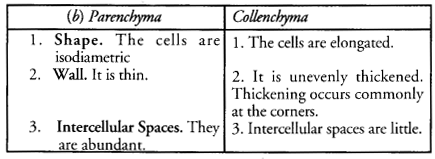
(c) Waxy coating or cuticle (cutin + wax) also provides strength to epidermis, protection against abrasive action of wind, attack by microbes.
Question 84.
Write one important function of
(a) Xylem
(b) Phloem
(c) Meristematic tissue. (CCE 2016)
Answer:
(a) Xylem: Transport of sap.
(b) Phloem: Translocation of food (organic nutrients),
(c) Meristematic Tissue: Cell division, producing cells for growth and differentiation.
Question 85.
Name the tissue associated with the following :
(a) Haversian Canal
(b) Chondrocyte
(t) Eosinophils. Give one function of each of these. (CCE 2016)
Answer:
(a) Haversian Canal. Bone. Endoskeleton.
(b) Chondrocyte. Cartilage. Parts of endoskeleton as ends of long bones, support for softer organs, (c) Eosinophils. Blood. Transport and immunity.
Question 86.
Answer the following :
- Draw a labelled diagram of smooth muscle
- Differentiate between parenchyma and collenchyma
- Mention the constituents of blood.
- Name the epithelial tissue which has hair like projections on the outer surface
- Name the tissue that stores fat in the body. (CCE 2016)
Answer:
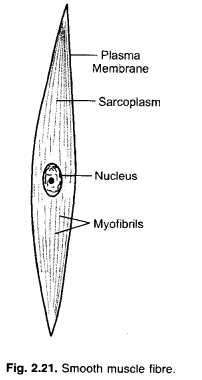

- Constituents of Blood: Plasma and blood cells. Blood cells are of three type—RBCs, WBCs and platelets,
- Ciliated: Ciliated Columnar and ciliated cuboidal.
- Adipose tissue.
Question 87.
(a) Mention two functions of stomata
(b) Which tissue surrounds stomata ? (CCE 2016)
Answer:
(a) Functions of Stomata:
- Gaseous Exchange: Stomata are sites where exchange of gases (carbon dioxide and oxygen) occurs between the plant interior and external environment.
- Transpiration: Major part of transpiration occurs through stomata. Transpiration removes excess water and keeps plant surfaces cool even in bright sun.
- Regulation: They regulate both gaseous exchange and transpiration.
(b) Epidermis.
Question 88.
(a) Blood is called fluid connective tissue. State reason.
(b) Name the various components of blood.
(c) State the main function of blood. (CCE 2016)
Answer:
(a) Blood as Fluid Connective Tissue:
- Blood is considered connective tissue as it contains cells suspended in a fluid matrix,
- Further, it connects all parts of the body receiving and providing materials every where.
(b) Components of Blood: Plasma or matrix – 55%, Blood cells – 45%. Plasma has 90 – 92% water, 8 – 10% organic and inorganic substances. Blood cells are of two types, haemoglobin containing red blood corpuscles (RBCs) and colourless white blood corpuscles (WBCs). Blood platelets are cell fragments present in blood.
(c) Main Function of Blood:
Transport: Blood transports gases, nutrients, hormones and waste materials to various parts of the body.
Long Answer Questions
Question 1.
(a) What is ligament ? Mention its function.
(b) What is areolar tissue and where is it formed ? Give its two functions. (CCE 2010, 2012)
Answer:
(a) Ligament: It is dense, cord-like fibrous connective tissue that binds a bone with another bone. Function. Because of its elasticity, ligament allows bending and rotational movements over a joint.
(b) Areolar Tissue: It is a simple connective tissue that possesses a jelly-like matrix, both white and yellow elastin fibres, fibroblasts, mast cells, plasma cells, macrophages and immunocytes.
Location: Inside and outside organs and tissues and as subcutaneous tissue.
Functions:
- Binding: Packing and Covering. Areolar tissue functions as binding, packing and covering tissue around and inside various body organs,
- Repair: Areolar tissue provides materials for repair of injuries.
Question 2.
(a) What is stratified squamous epithelium. State its functions.
(b) Name the type of tissue whose cells are filled with fat globules. State its functions. (CCE 2010, 2012, 2013)
Answer:
(a) Stratified Squamous Epithelium. It is a multilayered epithelial tissue whose basal layer lying in contact with basement membrane is capable of adding new cells to the outer layers.
Functions: It provides protection to underlying tissue from abrasion, mechanical stresses and irritating chemicals.
(b) Adipose tissue.
Functions:
- Storage of fat.
- Formation of shock absorbing cushions around important organs.
- Formation of insulation layer below the skin to protect from loss of body heat,
- Providing shape to body parts.
Question 3.
(a) Name four components of phloem.
(b) What is meristematic tissue ? State its different types. Show their locations in diagram of a plant body. Give classification of meristems. (CCE 2010)
Answer:
(a)
- Sieve tube cells
- Companion cells
- Phloem Parenchyma
- Phloem fibres.
(b) On the basis of location, meristematic tissue or meristem is of three types – apical, intercalary and lateral.
Classification: Primary and secondary. Primary Meristems. Apical, intercalary Secondary Meristems. Lateral meristems (vascular cambium, cork cambium)

Question 4.
(i) Define tissue. What is utility of tissues in multicellular organisms ?
(ii) Are plants and animals made of same types of tissues ? If no, then write the points of difference. (CCE 2013)
Answer:
(i) Tissue is a group of related cells that have a common origin and perform a common function.
Utility of Tissues:
- Division of Labour: Tissues bring about division of labour in multicellular organisms. It increases efficiency.
- Higher Organisation: Tissues become organised to form organs and organ systems.
- Individual Cells: Work load of individual cells has decreased.
- Higher Survival: Because of division of labour, higher efficiency and organisation, the multicellular organisms have high survival.
(ii) Tissues in Plants and Animals. Plants and animals are not made of same type of tissues.
Differences:
| Plant Tissues | Animal Tissues |
| 1. Abundance. Dead supportive tissues are more abundant as compared to living tissues. |
Living tissues are more common as compared to dead tissues. |
| 2. Maintenance Energy. They require less maintenance energy. | Animals require more maintenance energy. |
| 3. Basic Nature. There is differentiation of meristematic and permanent tissues. | Such a differentiation is absent. |
| 4. Meristematic Tissue. Due to its activity plants continue to grow throughout life. | It is absent. Animals do not show growth after reaching maturity. Reparative growth is, however, present. |
| 5. Organisation. It is simple. | Organisation is complex with the development of more |
| 6. Purpose. Tissue organisation is towards stationary habit. | specialised and localised organs and organ systems. Tissue organisation is towards high mobility. |
Question 5.
(a) Analyse the reason behind the following statements :
- Epidermis is thicker in desert plants though it is usually single layered
- Presence of waxy layer (secreted by spidermis) on the outer surface of plants.
(b) Discuss the cell arrangement which supports the fact that epidermis is a protective tissue. (CCE 2013)
Answer:
(a)
- Thick epidermis is a device to provide extra protection to desert plants against excessive transpiration and loss of turgidity.
- Waxy coating or cuticle (cutin + wax) also provides strength to epidermis, protection against abrasive action of wind, attack by microbes.
(b) Epidermis forms a complete covering having closely packed elongated cells with no intercellular spaces.
Question 6.
Identify the following muscular tissues and draw their diagrams :
(a) This tissue is mostly attached to bones and helps in body movements.
(b) This tissue is found in the iris of eye and bronchi of lungs.
(c) This tissue contracts and relaxes rapidly and rhythmically throughout life. (CCE 2013)
Answer:
(a) Striated muscle.

(b) Smooth muscle.
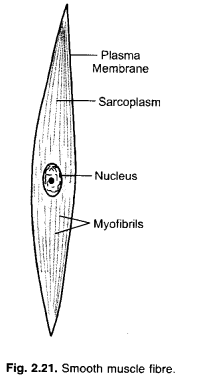
(c) Cardiac muscle.
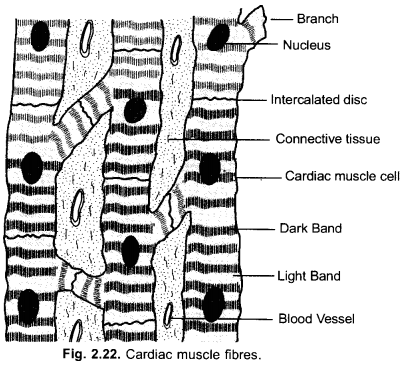
Question 7.
Name a connective tissue which is the hardest. What makes it so hard ? List any three important functions of this tissue. (CCE 2013)
Answer:
Bone: Bone is made hard by the deposition of carbonates and phosphates of calcium and magnesium in its matrix.
Functions,
- Attachment: Connective tissue binds different structures of the body, e.g., bone with bone, muscle with bone, muscle with skin.
- Packing: It forms the packing material in different organs.
- Various organs of the body are covered by protective sheaths of connective tissue.
- Connective tissue forms shock absorbing cushions around several organs, e.g., eye, heart, kidneys.
- Skeletal connective tissue (bones, cartilages) forms supportive framework of the body.
- Vascular tissue (fluid connective tissue) forms an internal transport system of the body.
- A number of cells present in the connective tissue provide protection against microbes and toxins.
- Storage: Fat is stored in connective tissue called adipose tissue.
- Formation of Blood Cells: Red bone marrow is a connective tissue specialised to form blood cells.
- Components of connective tissue are involved in repair of injuries.
Question 8.
(a) Draw a neat diagrams of transverse section of parenchyma tissue and label four parts on it.
(b) Write any two differences between parenchyma and collenchyma. (CCE 2013)
Answer:
(a)

(b)
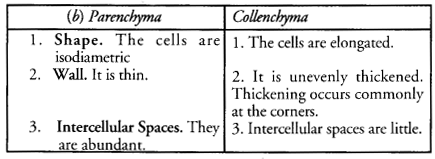
Question 9.
The growth of plant occurs in specific regions.
(i) Name the tissue which is responsible for this growth,
(ii) State the different types of this tissue,
(iii) Write one function of each of the above mentioned tissue. (CCE 2014)
Answer:
(i) Tissue: The tissue responsible for growth in specific regions of the plant is called meristematic tissue or meristem.
(ii) Types: Depending upon the region of occurrence, meristems are of three types—apical, intercalary and lateral. Apical meristem occurs over the tips of stem, root and their branches. Intercalary meristem occurs at leaf bases and above or below stem nodes. Lateral meristem is peripheral in stem and root. It has two types, vascular cambium and cork cambium.
(iii) Function:
- Apical Meristem. Growth in length of stem and root,
- Intercalary Meristem. Elongation of internodes, upward bending of lodged stems.
- Lateral Meristem. Growth in girth of stem and root and formation of cork or bark on their outside for protection.
Question 10.
Draw a labelled diagram of section of phloem. Name the four types of elements found in phloem. With respect to conduction, what is the main difference between xylem and phloem. (CCE 2014)
Answer:
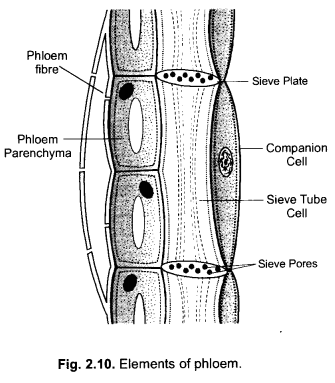
Four Elements. Sieve tubes, companion cells, phloem parenchyma and phloem fibres.
Differences in Conduction:
| Xylem | Phloem |
| 1. Conduction. Xylem conducts sap (water + minerals) | 1. It conducts organic solutes or nutrients. |
| 2. Direction : Conduction is mostly unidirectional, upwardly from roots to stem tips and leaves. |
2. Conduction is often bidirectional from leaves to roots and stem tips. |
Question 11.
Based upon their location and function differentiate amongst the three types of meristematic tissues. Draw a diagram to show the location of the three tissues in a plant. (CCE 2014)
Answer:
Types: Depending upon the region of occurrence, meristems are of three types—apical, intercalary and lateral. Apical meristem occurs over the tips of stem, root and their branches. Intercalary meristem occurs at leaf bases and above or below stem nodes. Lateral meristem is peripheral in stem and root. It has two types, vascular cambium and cork cambium.
Function:
- Apical Meristem. Growth in length of stem and root,
- Intercalary Meristem. Elongation of internodes, upward bending of lodged stems.
- Lateral Meristem. Growth in girth of stem and root and formation of cork or bark on their outside for protection.

Question 12.
Complete the following table for plants.

Answer:
A—xylem.
B—phloem.
C—vessels.
D— tracheids.
E—xylem fibres.
F—xylem parenchyma.
G—sieve tubes.
H—companion cells.
I—phloem, parenchyma.
J-phloem fibres.
Question 13.
(a) Show a diagrammatic representation of the location of lateral meristem and intercalary meristem in plant body.
(b) Name the meristem responsible for increase in girth of root or stem.
(c) Write two difference between meristematic and permanent tissues in a tabular form. (CCE 2014)
Answer:
(a)
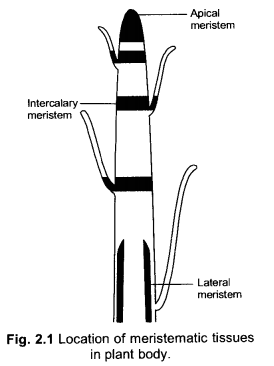
(b) Lateral meristem.
(c)
| Meristematic Tissue | Permanent Tissue |
| 1. Nature. The cells are small, isodiametric and undifferentiated. |
The cells are large, differentiated with different shapes. |
| 2. Spaces. Intercellular spaces are absent. | Intercellular spaces are often present. |
| 3. Vacuoles. They are nearly absent. | Large central vacuole occurs in living permanent cells. |
| 4. Nucleus. It is large and prominent. | Nucleus is less conspicuous. |
| 5. Wall. Cell wall is thin. | Cell wall is thin or thick. |
| 6. Divisions. The cells undergo regular divisions. | The cells do not normally divide. |
| 7. Metabolism. Rate of metabolism is high. | Metabolic rate is comparatively slower. |
| 8. Life. The cells are living. | The cells may be living or dead. |
| 9. Function. It takes part in growth. | It provides protection, support, conduction, photosynthesis, storage, etc. |
Question 14.
(a) Draw diagram of neuron and label the following points on it
- Single long part of nerve cell
- Short branched parts
- Nucleus
- Cell body.
(b) Name two tissues whose combination enables animals to move rapidly in response to stimuli. (CCE 2014)
Answer:
(a)
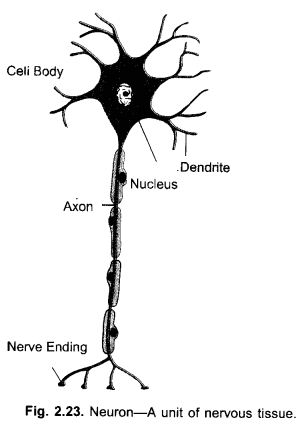
- Axon
- Dendrons.
(b) Nervous and muscular.
Question 15.
(a) Explain the formation of complex permanent tissues in plants. Mention the two types of complex tissues and write their functions.
(b) How simple permanent tissues are different from complex permanent tissues ? (CCE 2014)
Answer:
(a) Terrestrial plants being large and fixed not only require supportive tissues but also conducting tissues. Conducting tissues are complex. They have both supportive and conducting elements. The two types of complex plant j tissues are xylem and phloem.
Functions:
Xylem—Transport of sap (water + minerals).
Phloem —Translocation of food.
(b) Differences:
| Simple Tissues | Complex Tissues |
| 1. Cells: A simple tissue is formed of only one type of cells. | A complex tissue is made of more than one type of cells. |
| 2. Activity: All the cells perform the same function. | The different cells perform different fractions of a function. |
| 3. Types: There are three types of simple plant tissues— . parenchyma, collenchyma and sclerenchyma. | There are two types of complex plant tissues— xylem and phloem. |
| 4. Function: They form primary structure of the plant. | They form transport system of the plant. |
Question 16.
(a) Define epithelial tissue.
(b) Name the type of epithelial tissue found in the following j organs. Also draw the diagram of each tissue :
- Skin
- Inner lining of intestine
- Ducts of salivary glands, (CCE 2014)
Answer:
(a) Epithelial tissue or epithelium is unilayered or multilayered animal tissue of compacdy arranged cells that overlies a basement membrane and forms a covering over external and internal surfaces of body parts.
(b)
- Skin: Stratified squamous epithelium.
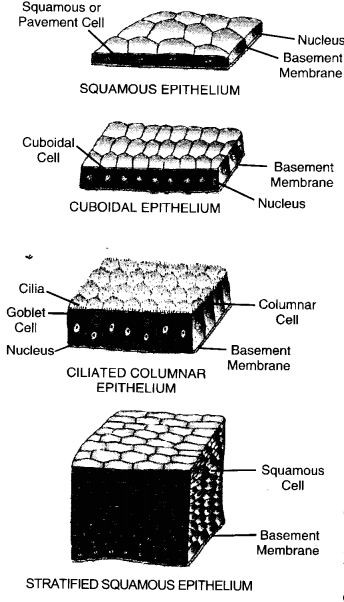
- Inner Lining of Intestine: Simple columnar epithelium, (but no cilia)
- Ducts of Salivary Glands: Stratified cuboidal epithelium.
Question 17.
(a) Draw a neat diagram of transverse section ot collenchyma tissue and label any four parts on it.
(b) Write two differences between parenchyma and collenchyma tissue. (CCE 2014)
Answer:
(a)
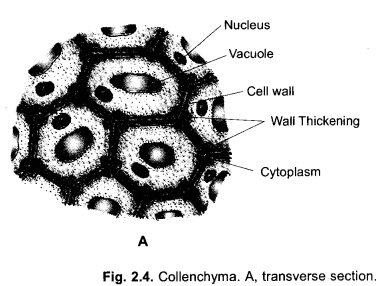
(b)
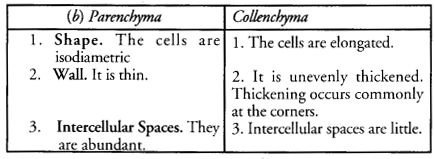
Question 18.
Draw a labelled diagram of unstriated muscle tissue and mention its occurrence, features and functions. (CCE 2014)
Answer:
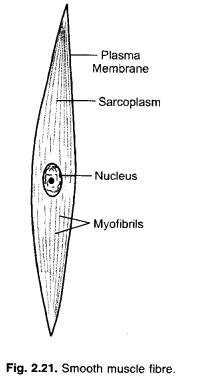
Occurrence. Inside visceral organs of the body like gastrointestinal tract, blood vessels, bronchi, urinary bladder, iris, etc.
Features:
- Spindle shaped, unbranched,
- Contractile myofibrils present but do not form striations,
- A single central nucleus.
Functions: They perform sustained involuntary contractions without getting fatigued.
Question 19.
Complete the following table : (CCE 2015)

Answer:
Husk of coconut : Tissue – Simple. Types of Tissue – Sclerenchyma. Cells – Dead. Main function – Mechanical strength / protection.
In leaf stalk below epidermis : Tissue – Simple. Type of Tissue – Collenchyma. Cells – Living. Main function – Mechanical strength with flexibility.
Question 20.
Name the tissue whose cells are highly specialized for being stimulated and then transmitting the stimulus from one place to another within the body. Mention three organs in our body which are composed of this tissue. What are the cells of this tissue called ? Name two tissues in animals the combination of which enables animals to move rapidly in response to stimuli. (CCE 2015)
Answer:
- Tissue: Nervous tissue
- Organs: Brain, Spinal cord, Nerves
- Cells: Neurons
- Tissues for Mobility: Skeletal tissues, Muscular tissue.
Question 21.
Analyse the significance of specialised epithelial tissue present in the following :
(a) Ciliary columnar epithelium in respiratory tract
(b) Stratified squamous epithelium in skin
(c) Cuboidal epithelium in kidney tubules
(d) Columnar epithelium in inner lining of intestine
(e) Squamous epithelium in lining of oesophagus.
(CCE 2016)
Answer:
(a) Ciliary Columnar Epithelium in Respiratory Tract. Pushing out the trapped dust particles and microbes.
(b) Stratified Squamous Epithelium in Skin. Protection from injury, abrasion, irritating chemicals and entry of germs.
(c) Cuboidal Epithelium in Kidney Tubules. Secretion and reabsorption.
(d) Columnar Epithelium in Intestine. It is specialised to absorb nutrients.
(e) Squamous Epithelium in Oesophagus. Protection against abrasion, microbes and toxins.
Question 22.
Name two simple permanent tissues which have living cells. Write two distinguishing features of each. Mention their location and functions. (CCE 2016)
Answer:
Simple Permanent Tissues with Living Cells. Parenchyma, Collenchyma.
Parenchyma
Features:
- Thin-walled nearly isodiametric
- Cells are loosely packed with intercellular spaces.
Location:
- In all parts of the plant body (stem, root, leaves, flowers, fruits, seeds),
- Mesophyll of leaves.
Functions:
- Storage of food,
- Providing turgidity or rigidity to soft parts by remaining turgid.
- Chlorenchyma as seat of photosynthesis.
- Aerenchyma having large air cavities for providing buoyancy,
- Epidermis forming external covering of softer plant parts.
Collenchyma
Features: The cells possess uneven thickenings of pectocellulose.
Location: Below epidermis in herbaceous dicot stems, leaf stalks and midribs.
Functions:
- It is living mechanical tissue which provides both mechanical strength and flexibility
- The tissue allows growth,
- It takes part in storage,
- It may contain chloroplasts and take part in photosynthesis.
Question 23.
(a) Show the diagrammatic representation of location of lateral meristem and intercalary meristem in plant body
(b) Name the meristem responsible for increase in girth of < root or stem,
(c) Write two differences between meristematic and permanent tissues in a tabular form. (CCE 2016)
Answer:
(a)
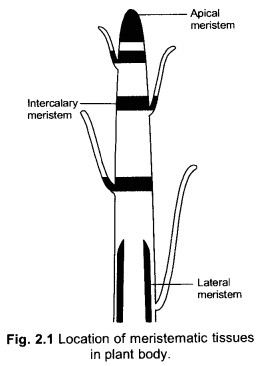
(b) Lateral meristem (mainly vascular cambium).
(c)
| Meristematic Tissue | Permanent Tissue |
| 1. Nature. The cells are small, isodiametric and undifferentiated. | The cells are large, differentiated with different shapes. |
| 2. Spaces. Intercellular spaces are absent. | Intercellular spaces are often present. |
| 3. Vacuoles. They are nearly absent. | Large central vacuole occurs in living permanent cells. |
| 4. Nucleus. It is large and prominent. | Nucleus is less conspicuous. |
| 5. Wall. Cell wall is thin. | Cell wall is thin or thick. |
| 6. Divisions. The cells undergo regular divisions. | The cells do not normally divide. |
| 7. Metabolism. Rate of metabolism is high. | Metabolic rate is comparatively slower. |
| 8. Life. The cells are living. | The cells may be living or dead. |
| 9. Function. It takes part in growth. | It provides protection, support, conduction,photosynthesis, storage, etc. |
Question 24.
(a) Draw a neat diagram of transverse section of collenchyma tissue and label on it any four parts,
(b) Write , any two differences between parenchyma and collenchyma.
(CCE 2016)
Answer:
(a)
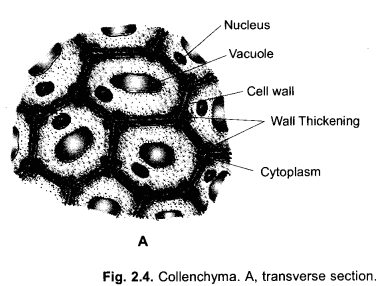
(b)
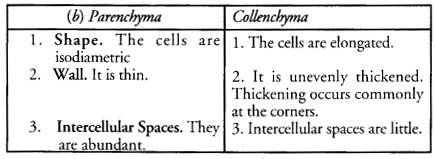
Hope given Previous Year Question Papers for CBSE Class 9 Science Chapter 6 Tissues are helpful to complete your science homework.
If you have any doubts, please comment below. Learn Insta try to provide online science tutoring for you.